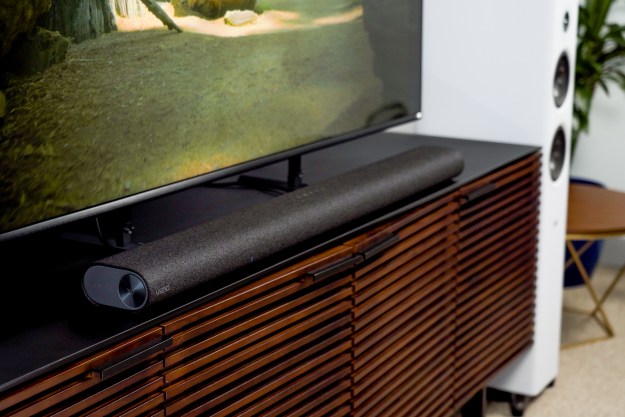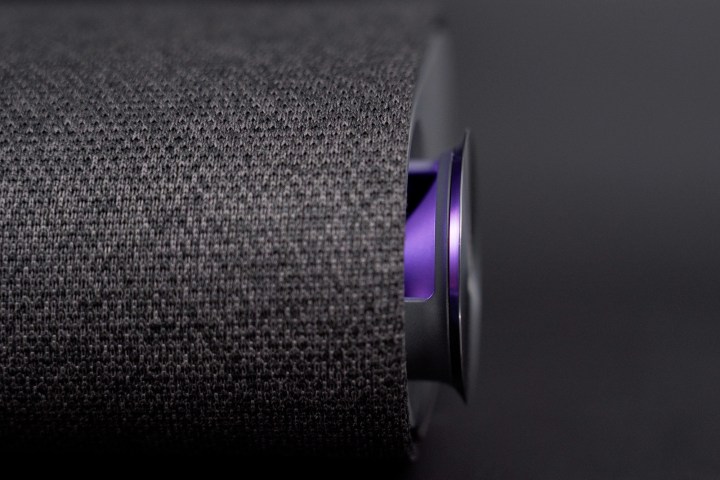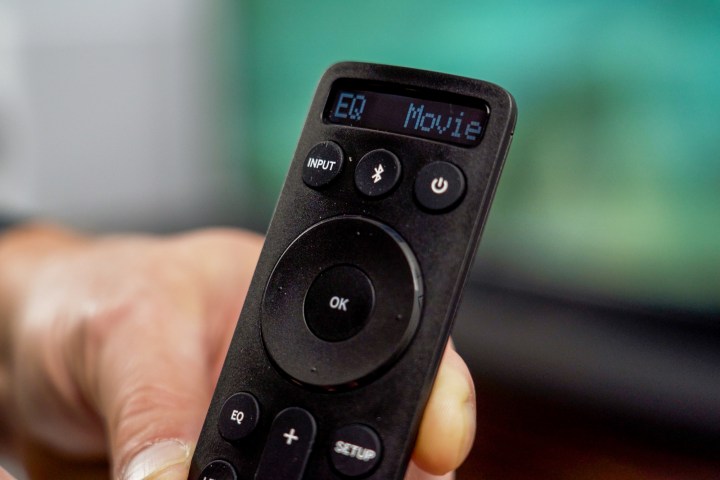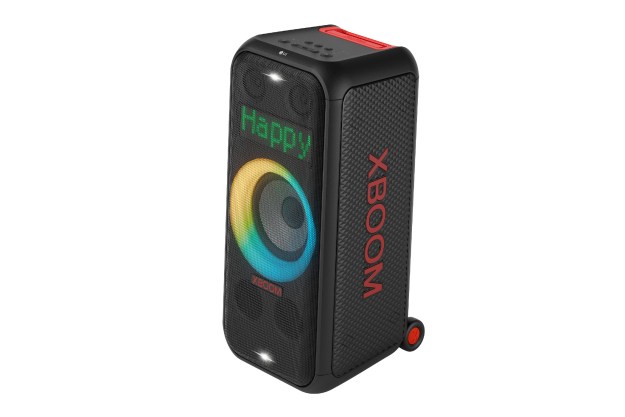
“The M-Series Elevate 5.1.2 is a scintillating Dolby Atmos system at a sweet price.”
- Super-easy setup
- Sleek design
- Robust sound
- Big soundstage
- Height effects need a little boost
Type “Dolby Atmos soundbar” into your search engine of choice and prepare for frustration. Ranging from as little as $350 all the way up to $2,000, these one-box solutions vary greatly both in price and capability. Some systems come with surround speakers, some don’t. Some come with a subwoofer, and some don’t. Some are easy to set up, and some are not. What are you supposed to buy? If only there was a Dolby Atmos soundbar system that ticked all the right boxes: Easy setup, great sound, reasonable price.
The Vizio M-Series Elevate 5.1.2 Dolby Atmos soundbar system does exactly that. Read on to find out why Vizio’s latest sonic triumph makes a whole lot of sense for a whole lot of people.
Video review
Out of the box
The only thing I don’t like about the Vizio M-Series Elevate is its packaging. To be fair, I generally dislike most soundbar surround-system packaging. But there’s something about the gobs of tape and far-too-numerous cardboard tabs on Vizio’s soundbar systems that rubs me the wrong way. They are a pain in the rear to open. But if you can get past that first arduous step, it’s nothing but smooth sailing from there.
It’s rare that I have much to say about how a soundbar system looks, but one of the Vizio M-Series Elevate system’s finer attributes is that it is a pretty sleek-looking little system. The soundbar is low-slung with rounded-off edges and covered in high-quality fabric. The surround speakers are similarly low-profile in stature, thus can be easily placed in a room without being an eyesore. The included wireless subwoofer is similarly sleek and compact, with an unassuming oval shape that, at first blush, doesn’t scream subwoofer.

Along with the speaker components comes just about everything one needs to get the system connected and operational, all tucked into one accessories box. There are two power cords — one for the soundbar, the other for the subwoofer — two exceedingly long surround speaker cables with color-coded RCA jacks on either end, aremote control with batteries, wall-mounting hardware with a wall-mount template, and a green color-coded HDMI cable. You won’t find a digital optical audio cable or analog audio cables in the box — though the soundbar does support those connection options — but I’ve got no gripe with that since most folks will want to connect this soundbar via HDMI for Dolby Atmos audio. Besides, who among us doesn’t have a bin full of cables we don’t use?
Setup and connections
Setting up a surround sound system doesn’t get much easier than it does with the Vizio M-Series Elevate. The back of each surround speaker has a color-coded RCA jack that matches up with jacks on the back of the wireless subwoofer. Connect the provided color-coded RCA speaker cable between the two components, plug the subwoofer into a power outlet, and the back half of the system is ready to go.
When I powered the system up, it was immediately ready to go.
For the soundbar, only two connections need to be made: HDMI and power. The green color-coded HDMI cable goes into the corresponding green port on the back of the soundbar, and then into an HDMI port marked ARC or eARC on the back of a TV. There is an HDMI input on the back of the soundbar should you want to connect a source directly to the soundbar and pass the signal along to the TV, but for most folks, the simplest setup will be to let the TV be the connection hub and allow audio to flow to the soundbar from the TV.
There is one aspect of setup with which I feel Vizio could do a better job, specifically for owners of Vizio’s own M-Series Quantum X (MQX) TVs. Thanks to little “nubs” on an MQX TV, the M-Series Elevate can actually be attached to the TV’s legs. This isn’t covered in the soundbar’s manual, nor is it obvious in the TV manual. It can be done, though, and provides the sleekest setup. Otherwise, folks will need a generous amount of depth on their media stand to accommodate the depth of the TV along with the depth of the soundbar. Of course, if you’re wall-mounting, none of that is a concern.

There are sync buttons on the back of the M-Series Elevate soundbar and subwoofer for linking the two together, but I doubt you’ll need to use them. When I powered the system up, it was immediately ready to go.
Control
Having control over every channel in a Dolby Atmos surround system is crucial to getting the best possible sound out of a variety of setup situations. Some folks will need to place the surround speakers very close to their seating area, others will need to place them far away. Sometimes the left speaker will need to be placed further from the listening area than the right or vice versa. Some people may have larger rooms that need more bass output, others may need to trim down the subwoofer to work better in a smaller space. Without independent channel control, none of this is possible. Thankfully, the Vizio M-Series Elevate offers all the granular controls needed to dial things in.
The tool for these adjustments is the included remote control, which features a small LCD screen at the top. Levels for right, left, center, surround, surround balance, height, and subwoofer are included. There are also broad treble and bass adjustments available, as well as several EQ presets and a dialogue level adjustment. Everything you need is here.

For basic volume control, a TV’s remote will work just fine, as the M-Series Elevate will gladly take its instructions from a TV, provided the TV has HDMI CEC turned on in its settings menu.
Since I connected the M-Series Elevate to a new Vizio MQX TV, I didn’t have to do anything to get the optimal signal sent to the soundbar, but some folks may need to tinker with their TV’s audio output settings to ensure the HDMI ARC is turned on and that it is sending a bitstream (not PCM) signal to the soundbar.
Some Vizio TVs also allow quick access to a few audio settings adjustments in their own audio menus, allowing users to stash the soundbar remote after setup has been completed.
Sound quality
I’ve been testing Vizio soundbars for several years now — most recently the M-Series All-in-one, the M-Series 5.1.2 (non-elevate) Dolby Atmos soundbar, and the original P-Series Elevate Dolby Atmos soundbar — so I had a good feel for what to expect going into my evaluation of the M-Series Elevate. Still, this soundbar system managed to surprise me a few times.
Perhaps the most remarkable thing about the M-Series Elevate system is that its subwoofer performs far better than I expected. Given its diminutive size and rather cheap-feeling cabinetry, I expected the kind of bass performance that I find more annoying than beneficial. Instead, what I heard was downright respectable for a system of this size and cost. The low end had plenty of punch and rumble without sounding tubby or just … noisy. Is it high-quality, audiophile-approved bass performance? Absolutely not. But I can think of several soundbar systems that had far worse-sounding bass coming from much larger subwoofer boxes. It’s hard not to see Vizio’s design here as something of a win.
The M-Series Elevate was always intelligible and, at times, flat-out pristine.
I was also concerned that the system would lean too hard on the subwoofer, given that all of the other speakers were very small. It’s not uncommon for these one-box solutions to require the subwoofer to cover frequencies well into the midrange, at which point locating the source of the sound (the subwoofer) becomes very easy. For example, with poorly designed systems, one might hear the higher frequencies of a deep voice coming from the soundbar, with the lower frequencies very clearly coming from wherever the subwoofer is placed in the room. This is not desirable. With better-designed systems, the voice should seem to come from the center of the soundbar, with perhaps an omnipresence that doesn’t seem to come from any particular place. The Vizio M-Series pulls off this sonic trick well.
Since we’ve moved on to talk of voices (see what I did there?), I’m happy to report that dialogue clarity with the M-Series Elevate was always intelligible and, at times, flat-out pristine. The M-Series Elevate may use fairly small drivers inside, but they certainly don’t sound small. In fact, not once did I have to use the dialogue level adjustment feature. And beyond the meat of the vocal range, the midrange response was generally open and uncontested, enhancing the perceived clarity of the system.
Treble frequencies also came through with clarity, cleanliness, and just enough detail to make me grin while watching movies for which the sound foley artists no doubt had quite some fun creating sound effects for simple actions like opening a door or walking across a dusty wooden floor. I felt like the creak of squeaky door hinges and the crunching of grit under a cowboy boot were palpable. That’s pretty impressive from a soundbar that is priced well in the midrange territory.

Aside from impressive fidelity for the price, I also enjoyed the seamlessness with which surround effects passed back and forth from the soundbar to the surround speakers. At times, I felt completely encircled in surround sound, with audible effects coming from points in the room in which there were no speakers. Part of that is owed to the M-Series Elevate soundbar’s surprisingly wide soundstage, which is further enhanced by the fact that the Dolby Atmos “height” drivers are actually aimed at the listener when anything other than a Dolby Atmos track is being plated.
But what about when the M-Series Elevate goes into Dolby Atmos mode? What then? Well, that gets its own section.
Dolby Atmos quality
At some point, I’ll pen a diatribe on the dilution of the Dolby Atmos brand. But for now, please allow me to simply spell out what kind of Dolby Atmos effect the M-Series Elevate can deliver.
In short, it’s far better than no Atmos at all. While the M-Series Elevate doesn’t quite deliver the “dome of surround sound” I hope for any time I listen to any Dolby Atmos-enabled product (and it can be argued that isn’t what I should be expecting, I suppose), the system does offer noticeable height effects and a much larger soundstage than systems that have no up-firing drivers at all.
Perhaps I’m spoiled by the slightly more expensive (albeit less sleek, if you ask me) P-Series Elevate soundbar, but I think that having four height speakers (5.1.4) is really essential for convincing dome-like Dolby Atmos sound. There were times when I was auditioning the M-Series Elevate when I wasn’t entirely sure I was hearing anything out of the Atmos speakers, which had been turned upward to fire off my ceiling. Now, to be clear, the space in which I auditioned this system has acoustic drop ceiling tiles, which are not optimal for refracting sound. Still, I’ve auditioned many Dolby Atmos systems in this space and heard slightly more convincing effects. I’ll also point out that the popcorn ceilings and vaulted ceilings found in many homes across North America are also not ideal for refracting sound back down toward the listener. With that in mind, I have a baseline expectation for Dolby Atmos, and hope for it to be met.

The M-Series Elevate got there, but only just. At one point, I backed every channel but the height channels all the way down and jacked the height channels all the way up to get as clear a presentation of the Atmos effects as I could. They were there, and they were fairly loud, but they seemed like they were coming from the bar more than the space above me. Still, when combined with the rest of the speakers in a balanced manner, they clearly added a sense of depth, height, and realism that went missing when I backed the height channels all the way down.
All of this to say that while the M-Series Elevate might not deliver the most jaw-dropping Dolby Atmos effects specifically, but its overall presentation is still pretty jaw-dropping, and the height channels are certainly doing their fair share of work. Without them, the system wouldn’t sound nearly as robust.
The bottom line
Sure, this was a pretty long review for a soundbar, but to be fair, I gave up the goods at the very beginning: The M-Series Elevate 5.1.2 Dolby Atmos soundbar systems ticks all the boxes at a very approachable price that’s only going to get more attractive over time. If you’re looking for an excellent-sounding soundbar system with a tasty sprinkling of Dolby Atmos effects, you’ll be hard-pressed to find a sleeker, easier-to-use, more potent-sounding system for the money. The Vizio M-Series Elevate presently defines the whole “bang for the buck” concept.
Editors' Recommendations
- Bluetooth on Sonos’ new Era speakers isn’t what you think – it’s better
- What is Sonos? The speakers, app, and everything you need to know about wireless music
- The first Roku-made televisions are now available at Best Buy
- 11 Sonos tips, tricks, and little-known features
- Sonos’ new Era 100 and Era 300 wireless speakers go all-in on spatial audio and Bluetooth







